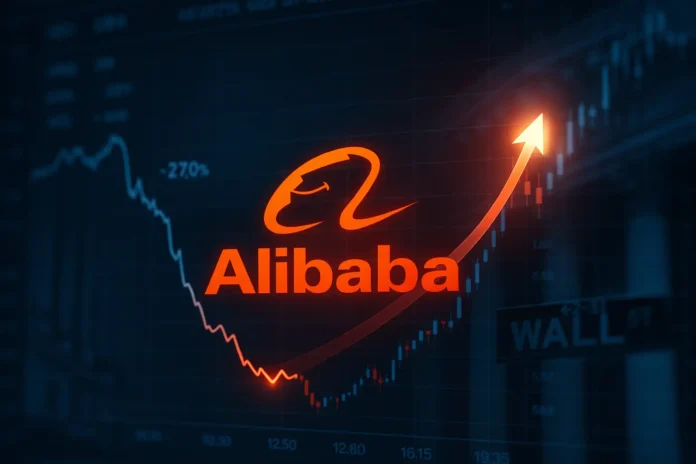NEW YORK (RoxNN)– Alibaba Group Holding Ltd. (NYSE: BABA) saw a pre-market uptick of over 3% today, offering some relief to investors after a challenging few months. The e-commerce and cloud computing giant has been under pressure since hitting its 2025 peak, dropping more than 27% due to disappointing earnings and capital market moves.
Despite the recent dip, the stock has gained over 27% year-to-date, indicating long-term strength amid short-term turbulence.
What Triggered the Drop? A Look at the Decline
Alibaba’s downward trajectory began following a disappointing March-quarter earnings report, which revealed net income far below analyst expectations. This earnings miss triggered widespread concerns over the company’s short-term profitability and growth trajectory.
At the same time, fierce competition from domestic rivals such as Pinduoduo (PDD), JD.com, and ByteDance has continued to pressure Alibaba’s e-commerce dominance. These firms have been aggressively expanding into digital retail and cloud services, eroding Alibaba’s market share across core segments.
$1.53 Billion Bond Issuance Raises Questions and Capital
Adding to the volatility, Alibaba announced earlier this month that it would raise $1.53 billion through exchangeable bonds tied to its healthcare affiliate, Alibaba Health. While the company clarified that the capital will be used for investments in cloud infrastructure and artificial intelligence, the move raised eyebrows among investors already wary of diluted earnings per share.
According to a statement, the bonds will not carry any interest payments and will mature in July 2031, signaling a long-term financing strategy. This comes on the heels of a larger bond sale in November 2024, further indicating Alibaba’s capital-intensive approach to innovation and expansion.
Short-Term Recovery Signals Appear on the Chart
Despite recent setbacks, several indicators point to a potential rebound. Alibaba’s forward price-to-earnings (P/E) ratio has dropped to around 11–12x, a valuation that analysts say makes the stock attractive within the large-cap tech universe.
Wall Street analysts remain largely optimistic. Out of 21 top-rated analysts tracked by multiple financial platforms, 19 rate BABA a “Strong Buy” or “Buy”, with a consensus price target near $163. That reflects a potential upside of more than 50% from current levels.
Furthermore, Alibaba has continued its aggressive stock buyback program, repurchasing a significant number of shares in the first half of 2025. This has helped instill confidence among long-term shareholders.
China’s Macro Landscape and Regulatory Risks Loom Large
While Alibaba may be showing signs of stabilization, external challenges remain. The China–U.S. geopolitical landscape continues to cast uncertainty over tech firms with global reach, and the lack of robust stimulus from Beijing has further complicated the recovery for domestic giants like Alibaba.
On the regulatory front, tech-sector scrutiny in China remains high, although the intensity has somewhat reduced compared to the 2021–2022 cycle. Nonetheless, policy shifts and enforcement unpredictability continue to be key risk factors for Alibaba’s near-term trajectory.
Cloud and AI Strategy at the Core of Future Plans
Looking ahead, Alibaba is doubling down on cloud computing, AI infrastructure, and instant delivery commerce. The company is reportedly investing upwards of $50 billion into its cloud division over the next three years, with AI-related product growth continuing in the triple digits.
CEO Eddie Wu has emphasized that the next decade of growth will rely on deep tech innovation. These long-term investments may not offer immediate returns but could strengthen Alibaba’s competitive positioning by the end of the decade.
Recovery in Sight, But Headwinds Remain
Alibaba’s 3% jump in pre-market trading suggests renewed investor interest following a steep multi-month correction. While aggressive investments in cloud and AI signal a future-oriented strategy, risks including global macro tensions, regulatory challenges, and fierce market competition cannot be overlooked.
The company’s long-term fundamentals remain intact, but its short-term performance will likely depend on the execution of its tech investments and the stability of China’s economic policies.
📌 This news article is intended for informational reporting only. It does not contain or imply any investment advice.
📅 Published on: July 9, 2025 | Source verified via Reuters, Yahoo Finance, MarketWatch, and TradingView.

